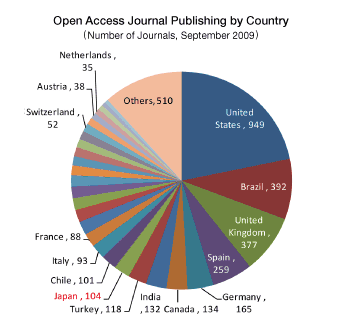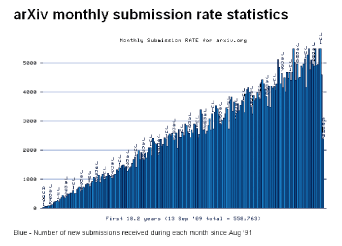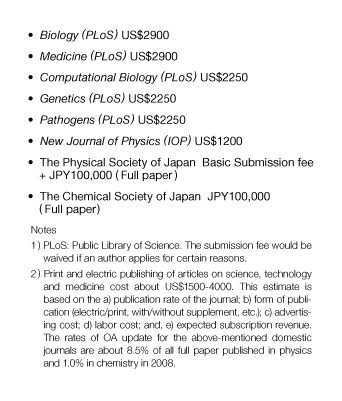Mikiko Tanifuji
(National Institute for Materials Science)
● Introduction
Science and Technology of Advanced Materials (STAM) is an English-language journal published by the publications department of Japan’s National Institute for Materials Science. STAM is a publicly-funded journal for researchers working in the forefront of materials science. It began as a subscription-based print journal in 2000, and the entire process of publication from copy-editing to marketing was outsourced to Elsevier, the giant Dutch publisher. STAM became an open access journal in 2008, when the editorial board recognized that the print journal was failing to increase the number of subscribers or its name recognition. This was despite the dedicated efforts of the board over seven years, which had included actively inviting the submission of papers and ensuring timely publication.
Shortly after writing an article for the Journal of Information Management ‘Johokanri’ (issued on September 1, 2009)1 about STAM’s change to an open access model of publishing the National Institute of Informatics (NII) requested that I write an article on the same topic.
Because my article in Johokanri already contains detailed information about the changes in our publication strategy, in this article I will concentrate on the current situation of open access publishing for academic journals. Here, I use "academic journal(s)" to refer to the journals and periodicals that publish peer-reviewed articles in order to disseminate the latest research findings and scientific developments to a wide academic readership.
Today, there is a vast amount of information available on the Internet, and increasingly users take it for granted that they can get online information at no charge, and academic information is no exception to this principle. The ease of access to information has created the idea in many Internet users that paying for worthwhile information is now out of date. It is not uncommon to encounter people who believe that all the scholarly information and all academic articles should be available free of charge, so that everyone can equally share the latest scientific knowledge.
● Open Access Publishing and Open Access Journals
 Figure 1: Open Access Journals in the World
Figure 1: Open Access Journals in the World

Source: Directory of Open Access Journal (www.doaj.org, accessed 2009-09-01)
Open Access is a no-fee online publishing model in which all publication costs are covered by revenue from advertising. However, this model is often unsuitable for academic or scholarly journals, because fees from advertising are insufficient to provide a sound financial basis for a journal that grants readers free access to their articles. Other stable sources of funding are needed to cover publication costs, which include items such as: conducting editorial work, which increases in proportion to the number of papers submitted and published; maintaining the publishing system; registering information, such as bibliographic data in third-party databases; advertising costs, and distribution costs. A journal can be converted from a paid subscription model to an open access model, only after ensuring it has stable and long-term funding.
Most open access journals charge publication fees, which are paid for by authors or organizations such as learned societies. The number of open access journals has gradually increased over the last ten years. The portal site of the Directory of Open Access Journal (DOAJ) contains more than 4,000 journals published in 50 languages from 98 different countries. These account for about 2% of all the published academic journals (Figure 1).2,3
● Open Access Repository and the Journal
 Figure 2: arXiv Monthly Submission of Articles
Figure 2: arXiv Monthly Submission of Articles

Source: arXiv.org
(http://arxiv.org/show_monthly_submissions, accessed 2009-09-13)
In Japan, when referring to institutional or subject repositories, people often use the term "open access publishing”. Repositories are organizational databases of research papers, educational materials and theses, and such databases are becoming commonplace in libraries. There is a history behind the open access repository, in which many libraries have been forced to cut journal titles from their lists of subscriptions, because journal costs have risen beyond their budget allocations.
In response to rising costs, in the early 1990s, librarians began to challenge the established system of journal publication. The worldwide movement to build institutional repository systems (or digital archives) as useful platforms of academic and scholarly output has grown during the last decade4. There are about 110 such repositories in Japan, and the support system for them varies from institution to institution. There are repositories hosted by a single institution, and repositories supported cooperatively by several institutions or scholarly associations, to which faculty members or researchers contribute their intellectual output5. The most significant benefit of the institutional repository is open access distribution of work (no fee charged to users); published articles, conference papers, or educational materials, and usually the host institutions, such as libraries, universities, and research institutes, provide funding for the construction, operation, and maintenance of the publishing platform. Such institutional repositories have become important as a way to showcase the quality of a host institution.
For future success, it will be important for both publishers and libraries to enrich their database services in a mutually complementary manner. Academic publishers can only publish materials which are encompassed by their editorial and review policies, but libraries can provide additional publishing platforms, such as open access repositories. In this sense, arXiv—an archive for electronic preprints of scientific papers—is a very forward-looking system. arXiv, in the field of high energy physics, was started in 1991 as a repository for preprints in physics. Back then it was known as the LANL preprint archive, and it was originally hosted at the Los Alamos National Laboratory. It later expanded to include mathematics, computer science, quantum physics, and materials science, and its hosting, operation, and funding have since been taken over by Cornell University. arXiv, an attractive medium for researchers, is a prototypical repository, as well as an advanced type of scientific publishing. Not that the arXive is operated by the library at Cornell University. (Figure 2)
● Production Costs for Academic Journals
 Figure 3: Examples of Manuscript Submission Fees Figure 3: Examples of Manuscript Submission Fees
Given the current surfeit of research papers waiting to be published, researchers can choose to publish their papers at their own expense and allow free access to them so as to attract as many readers as possible. This is known as the "author-paid" model. The actual cost per paper under this model is about 15,000 – 30,000 yen depending on the journal’s projected subscription revenue. A well-known predecessor of the author-paid model is the collection of online journals of the Public Library of Science (PLoS), which is regarded as the pioneer of open access publishing. An analysis of the average costs involved in the process of publishing and distributing was provided in a report commissioned by the Research Information Network.6 (Figure 3)
The other publishing model is the institution-sponsored model, in which scholarly associations or institutes subsidize the costs for open access online journals. Science and Technology of Advanced Materials (STAM) is published under this model by the National Institute for Materials Science (NIMS). A direct predecessor of STAM was the New Journal of Physics published by the Institute of Physics (IOP) in Britain. It is absolutely essential to establish and maintain a stable system of editing and publishing under the author-paid and institution-sponsored models. When a subscription-based journal changes to the open-access model and its subscription revenue therefore becomes zero, it needs other resources to cover its costs. In the case of STAM, its publication is one of the institution’s core activities, and its departmental budget is always secure. It is nevertheless necessary for STAM’s editorial board to provide accountability, by presenting a rational breakdown of its expenditures to NIMS. The editorial board therefore devoted two years to discussing a variety of methods and problems. The board discussed the following matters:

A) Method of publishing: What are the essential factors for publishing an academic journal?
|
| ● |
| Form of publication
It was decided to discontinue publishing a print version of the journal, and to only publish an online version. However, it was also decided to make print versions of special issues on particular high-interest topics or to print on demand articles when recommended by the editors, for distribution at conferences, seminars, and symposiums. |
| ● |
Timeliness
It was decided to publish a manuscript as soon as it had been accepted, and to replace the existing page numbering system with a sequentially numbered page count system. Researchers in different fields have responded differently to the new page count system. The physics community adopted this system in the early 1990s; the numbering system of their journals is a combination of numbers and letters corresponding to the discipline, field, and category. This system was soon accepted by physics researchers, and has became common practice in citations. However, scholars in other fields have criticized the system. Some say that it is likely to lead to missed citations, while others say that page numbering is no longer an important consideration now that we have Digital Object Identifiers (DOI). |
| ● |
Paper format
It was decided to publish articles as PDFs using the double-column format. Since readers usually print out articles if they wish to read them, the double-column format is more reader-friendly. But in the case of research articles containing mathematical expressions, sometimes the publication costs differ greatly between double-column and single-column format. |
| ● |
Author’s proofreading
Although it is common practice to return the manuscript to the author for proofreading at least once before being published, it was decided not to continue this practice and to let proofreading staff, who have special expertise in this area, carry out this task instead of the author. It was judged that changing this practise would be more economical and increase text accuracy. |
| B) Cost: What is the best investment? |
|
It is important to make the best use of resources in order to support the basic policy of online publishing. For example, is it best to convert a print periodical into print on demand or to shift mail correspondence entirely to web communications? In either case, our goal should be to offer a more effective and less costly service. In the case of STAM, the savings from abandoning the print version of the journal were used to pay for English-language proofreading. |
To summarize, in the age of the Internet, some aspects of traditional publishing can be modified, such as the page count system. Other aspects, such as designing a page style to be reader friendly, cannot be changed. Even the age difference among researchers does not matter; nonetheless, researchers and publishers have different perspectives arising from their different standpoints.
● Reconsidering the open access journal
Academic journals are the essential media to science The publisher of an open-access academic journal apply the same degree of dedication to its production as they would to a traditional print journal. Open access journals assume a very different role from the repositories to which everyone enjoys free access. They play a complementary role as a scholarly database. Some researchers wish to publish their articles in academic journals and deposit materials and information in a repository in order to be able to track biographical data when needed. In this case, self-archiving7 might be the best match for a researcher’s needs.
An academic journal has a difficult path to follow to gain visibility in the academic world. A journal’s success depends upon how many important papers and high-calibre researchers it is able to attract, and the reliability of the peer-review system it establishes. To have a high readership, a journal must have not only quality content, but also a sound financial foundation and the ability to support its community of scholars. Derek Haank, the current CEO of Springer said in 2008, "In the present situation, the OA model is a niche market in the business world of the science publishing industry… We will continue Open Access but it will not replace the traditional model (subscription-based model)." The adoption of the OA model is not the only choice for an academic publication, but can be a suitable alternative for researchers who want it. The open-access model was chosen for STAM because it was judged to be an appropriate tool to secure academic freedom in the materials science community. The view was also taken that the OA model was the best choice for the journal representing the leading institute of materials science in Japan, an institute that is expected to play an important role in the field. |

